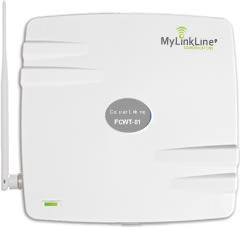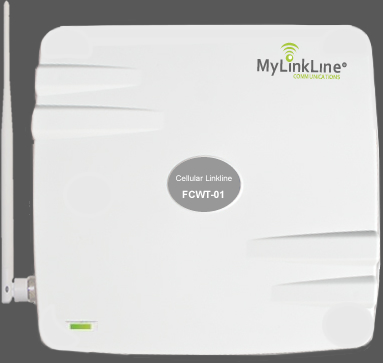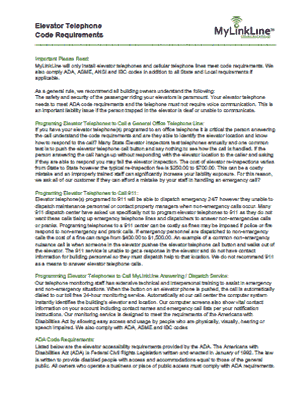Cut The Cord On Elevator Phone Landlines!
Replace your dedicated telephone landlines. Our code-compliant elevator cellular phone lines will save you 35% or more on monthly phone line fees

Elevator Phone Line Requirements and Code Compliance
Telephones for General Office Telephone Line:
If your elevator telephones are programmed to connect with an office telephone, it is crucial that the person answering the call understands the code requirements and can accurately identify the elevator’s location while knowing how to respond appropriately. Elevator inspectors often test telephones annually, including a common test where they push the elevator telephone call button and remain silent to observe how the call is handled.
If the person answering the call fails to provide the elevator’s location upon inquiry, it results in a failed elevator inspection. The cost of re-inspections varies, but they are typically significant. This kind of mistake can be costly, and an inadequately trained staff can greatly increase your liability exposure. That’s why we ask all our customers if they can afford the consequences of mishandling an emergency call.
Programming Elevator Telephones to Call 911:
Elevator telephones programmed to dial 911 can reach emergency services 24/7. However, they cannot dispatch maintenance personnel or contact property managers for non-emergency calls. Many 911 dispatch centers specifically request that elevator telephones not be programmed to call 911 to prevent tying up emergency lines and dispatchers with non-emergency or prank calls. The programming of telephones to a 911 center can incur costs, as fines may be imposed when police or fire respond to non-emergency or prank calls.
If emergency personnel are dispatched to non-emergency calls, the building owner may face fines. A common example of a non-emergency nuisance call is when someone presses the elevator telephone call button and exits the elevator without responding to the 911 service. Since the 911 service cannot receive a response from inside the elevator or access contact information for building personnel, they must send help to that location. We do not recommend using 911 as the primary means of answering elevator telephone calls.
Programming Elevator Telephones to Call MyLinkLine Answering/Dispatch Service: Our telephone monitoring staff undergoes extensive technical and interpersonal training to provide assistance in both emergency and non-emergency situations. When the button on an elevator phone is pressed, the call is automatically dialed to our toll-free 24-hour monitoring service. Our call center identifies the elevator and its location automatically.
Our computer screens display vital contact information from your account, including contact names and emergency call lists as per your instructions. Our monitoring service is designed to meet the requirements of the Americans with Disabilities Act (ADA), ensuring easy access and usage for individuals with physical, visual, hearing, or speech impairments. We also comply with ADA, ASME, and IBC codes.
ADA Code Requirements:
Here are the elevator accessibility requirements outlined by the ADA. The Americans with Disabilities Act (ADA) is a federal civil rights legislation enacted in January 1992 to provide disabled individuals with equal access and accommodations. Businesses and places of public access must comply with ADA elevator phone line requirements.
4.10.14 Emergency Communications:
If provided, emergency two-way communication systems between the elevator and a point outside the hoistway must comply with ASME A17.1. A17.1-1990 states that the highest operable part of a two-way communication system should be within 48 inches (1220 mm) from the floor of the car. It should be clearly identified with raised symbols and lettering according to section 4.30 and located adjacent to the device.
If the system uses a handset, the cord length from the panel to the handset should be at least 29 inches (735 mm). If the system is situated in a closed compartment, the compartment door hardware should conform to section 4.27, Controls and Operating Mechanisms. The emergency intercommunication system does not necessarily require voice communication.
ASME Code Requirements:
ASME 2.27.1.1 Emergency Communications:
“Tip: We recommend installing an elevator cellular phone line. The average cost savings is 35% compared to traditional, outdated telephone landlines.”
If provided, emergency two-way communication systems between the elevator and a point outside the hoistway must comply with ASME A17.1. A17.1-1990 states that the highest operable part of a two-way communication system should be within 48 inches (1220 mm) from the floor of the car. It should be clearly identified with raised symbols and lettering according to section 4.30 and located adjacent to the device.
If the system uses a handset, the cord length from the panel to the handset should be at least 29 inches (735 mm). If the system is situated in a closed compartment, the compartment door hardware should conform to section 4.27, Controls and Operating Mechanisms. The emergency intercommunication system does not necessarily require voice communication.
ASME A17.1:
It refers to the means of two-way conversation between the elevator car and a readily accessible point outside the hoistway, which is available to emergency personnel (telephone, intercom, etc.).
The means to activate the two-way conversation or both are normally connected to the building’s power supply. They should automatically switch to a source of standby or emergency power as required by the applicable building code or, in the case of healthcare facilities, the Standard for Health Care Facilities (ANSI/NFPA-99) after the normal power supply fails.
The power source should be capable of operating the audible signaling device and illuminating the alarm switch for at least one hour, and the means of two-way conversation for at least four hours.
In buildings where a building attendant (building employee, watchman, etc.) is not continuously available to take action when the required emergency signal is activated, the elevators should be equipped with a means inside the car for communicating with or signaling a service capable of taking appropriate action in the absence of a building attendant.
Elevator Phone Line Requirements
Elevator Phone Line Requirements – Testing Instructions
Elevator Phone Line Requirements – Testing Step 1 – Push the call button in the elevator.
The unit must be push-activated and the call button must be identified with the word “HELP.” To test, press “HELP” and the elevator telephone should dial a pre-programmed telephone number.
The programmed phone number should call a 24-hour monitoring service. When the phone is answered, the elevator phone will play a message to identify the emergency and building location
Most elevator phones with have a “Call Connected LED” that will turn on to show that communication with emergency personnel has been established. The visual communication provision can be as simple as a light, illuminated by emergency personnel. This function is designed for people with hearing impairments, that need a visual indicator that the phone call has been received and that help is on the way
Elevator Phone Line Requirements – Testing Step 2 – Ask the operator to state the building’s location or cab numbers, as required by ASME.
The monitoring service should be able to tell the location of the emergency calls by either the voice announcement or from the building’s elevator phone # “caller I.D”. If you have more than one elevator phone, verify calls can be made at the same time and also communicate with the answering service.
If you pass the two steps above your building elevator telephone service is working properly. We also recommend elevator phone testing by on a monthly basis.
IBC & ASME A17.1-2019
If your elevator is equipped with a two-way communication system that offers both visible text and audible modes, there are additional items that will need to be tested.
- In each mode of operation, it should feature a live interactive system enabling a two-way conversation between elevator occupants and emergency personnel.
- The system should be operational whenever the elevator is operational.
- The system should allow elevator occupants to choose between text-based or audible modes based on their communication needs when interacting with emergency personnel
MyLinkLine elevator monitoring service and cellular phone lines are designed to meet the updated elevator phone line requirements of the International Building Code (IBC) and ASME. Our cellular phone lines have the capability to transmit video and text messages, ensuring compliance with the new IBC code requirements. With MyLinkLine, you can have peace of mind knowing that your elevator communication system aligns with the latest elevator phone line requirements.
Still, have elevator phone line requirements questions? Call us at 800-862-4001. We will be happy to assist you.
WANT AN EXTRA 50% OFF YOUR FIRST PURCHASE?
Complete the online quote today and we will discount activation fees by 50% off the original price!
***This is a limited time promotional offer***



